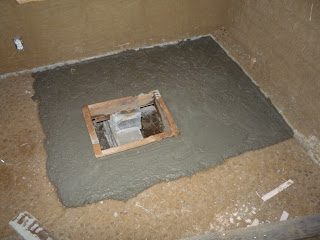The monarch butterflies flooded our fields this year to feed on nectar from the white snakeroot. I don't know what was going on with the migration or why they are suddenly in such great numbers this year. I've never seen so many in one place before. All the white flowers in the picture below are white snakeroot and each plant has 5-7 monarchs on it. There have got to be thousands in our fields.

I've also been working on the soffit and fascia. I had to build some extra supports to be able to get the scaffolding up as high as I needed it to do the gable end. It was pretty rickety up there, especially when the wind kicked up.



The base coat of plaster on the outside is now complete too, with the south side finally covered. I will work on the trim. There has been a run of equipment failures lately. Every day for four days in a row I had major equipment integral to my projects breaking down. First the handle on the electric planer broke, so I had to order a new handle. The next day my circular saw stopped working, and I'm guessing it is a bad switch, so I have to order one of those too. The next day I realized that my charge controller had not been charging my batteries in the last number of days so the batteries were run way down. I thought I had to get a new charge controller until I was able to fingure out the next day that the wires for the temperature sensor had become disconnected. Apparently this prevents the charge controller from giving current to the batteries. Then yesterday my water sprayer, which I use for spraying down the walls with water before plastering, stopped being able to pressurize its tank. I thought that applying earthen plaster would be a foolproof thing to do because it's such a simple process, but I guess being dependent on any kind slightly complex tool makes you vulnerable to these kinds of failures. Hopefully this is the last of them.





The late season has been pretty good in the garden. The cauliflower and broccoli I planted in April has finally gotten big enough to produce heads. It should have been ready to harvest in June or July at the latest. I've also been harvesting a lot of cucumbers, summer squash, edamame, eggplant, peppers, and beets. The pear I planted by the garden shed is bearing fruit this year. It is a variety that was growing in the yard of a rental property in Madison that my friends and I would always pick from. I took scionwood from that tree and grafted it onto a rootstock and have been moving it around for years until I found a permanent home for it near the shed. The pears are delicious. I plan to espalier the tree on the wall of the shed.
 The hoop house arrived in the last few days. It is much more heavy duty than I was expecting. The entire shipment weighed 2200 pounds. The unloading from the delivery truck showed how having a community of peole around can be really helpful. Within about ten minutes me and a bunch of other DR folks who pitched in were able to unload two pallets of really heavy metal parts. We brought some of it out to the hoop house site, but I'll be using the tractor to move the rest. It is going to be a big project to assemble it, but I would like to get it up in the next week or two so I can get something planted in it. If I can plant some greens in early or mid October, I can probably harvest some by December. I added a trailer load of composted manure to the area, I limed it, added wood ash, and ran the chickens over it. The soil test said the soil had a pH of 5.5 and needed potassium and phosphate. The ash adds potassium and the chickens phosphate.
The hoop house arrived in the last few days. It is much more heavy duty than I was expecting. The entire shipment weighed 2200 pounds. The unloading from the delivery truck showed how having a community of peole around can be really helpful. Within about ten minutes me and a bunch of other DR folks who pitched in were able to unload two pallets of really heavy metal parts. We brought some of it out to the hoop house site, but I'll be using the tractor to move the rest. It is going to be a big project to assemble it, but I would like to get it up in the next week or two so I can get something planted in it. If I can plant some greens in early or mid October, I can probably harvest some by December. I added a trailer load of composted manure to the area, I limed it, added wood ash, and ran the chickens over it. The soil test said the soil had a pH of 5.5 and needed potassium and phosphate. The ash adds potassium and the chickens phosphate.

No comments:
Post a Comment